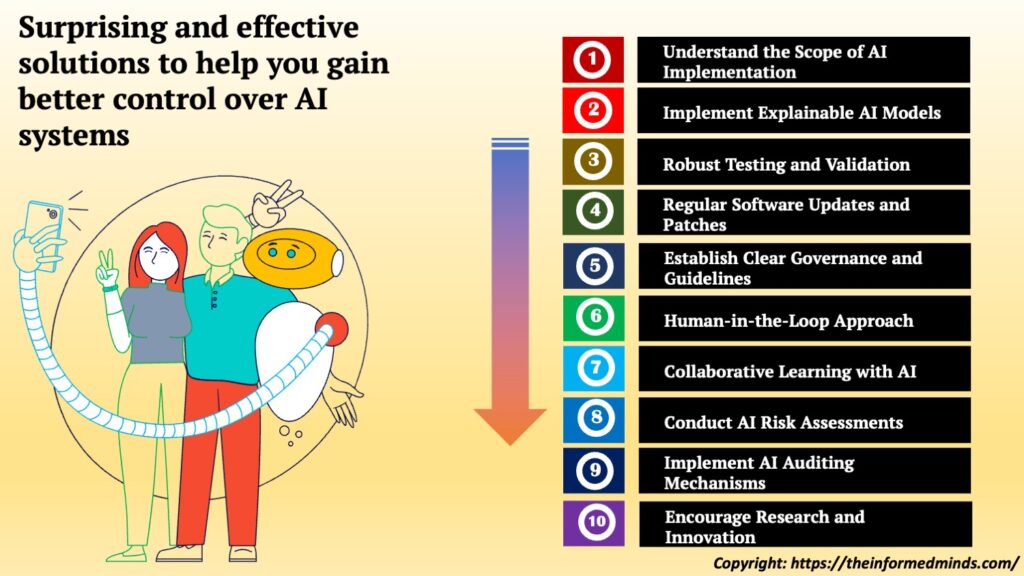To Share is to Show You Care!
In today’s fast-paced technological landscape, artificial intelligence (AI) has become an indispensable part of various industries, from healthcare and finance to entertainment and transportation. While AI brings incredible advancements, it also poses challenges when it comes to control and management. In this blog post, we will explore ten surprising and effective solutions to help you gain better control over AI systems.

1. Understand the Scope of AI Implementation

- Familiarize yourself with the specific AI technologies utilized in your systems.
- Identify potential risks and limitations associated with AI integration.
- Explore the scalability of AI for future business expansion.
- Evaluate the impact of AI on existing processes and workflows.
2. Implement Explainable AI Models
- Choose AI models that provide clear and interpretable results.
- Understand the reasoning behind AI decisions, ensuring transparency and accountability.
- Document the model’s decision-making process for auditing and validation purposes.
- Engage end-users in the design process to incorporate their feedback and concerns.

3. Robust Testing and Validation

- Thoroughly test AI systems in diverse scenarios to identify potential vulnerabilities.
- Use real-world data to validate AI performance and accuracy.
- Conduct stress tests to gauge AI behavior under extreme conditions.
- Implement validation mechanisms to ensure AI compliance with safety standards.
4. Regular Software Updates and Patches
- Stay updated with the latest AI advancements and security patches.
- Regularly update AI software to fix vulnerabilities and enhance performance.
- Monitor the performance of AI after each update to detect any anomalies.
- Develop a rollback plan in case of unexpected issues with new updates.

5. Establish Clear Governance and Guidelines

- Develop well-defined governance policies for AI system usage.
- Set guidelines and ethical frameworks to ensure responsible AI implementation.
- Educate employees about AI guidelines to ensure consistent adherence.
- Conduct regular compliance audits to identify and address any deviations.
6. Human-in-the-Loop Approach
- Employ a human oversight system to monitor AI decisions and intervene when necessary.
- Enable humans to provide feedback and improve AI algorithms continually.
- Implement clear escalation protocols to handle complex situations beyond AI capability.
- Train human operators to effectively collaborate with AI systems for optimal performance.

7. Collaborative Learning with AI

- Use AI systems to learn from human operators and vice versa.
- Foster a symbiotic relationship between humans and AI for enhanced control.
- Encourage employees to share their insights to improve AI algorithms.
- Organize workshops and brainstorming sessions for cross-learning between humans and AI.
8. Conduct AI Risk Assessments
- Perform thorough risk assessments to identify potential threats posed by AI.
- Develop risk mitigation strategies to minimize AI-related risks.
- Continuously monitor AI systems to identify emerging risks and address them promptly.
- Collaborate with cybersecurity experts to assess AI vulnerabilities and improve security measures.

9. Implement AI Auditing Mechanisms

- Set up AI auditing processes to review and evaluate AI system performance regularly.
- Ensure compliance with industry regulations and ethical standards.
- Conduct independent third-party audits to gain unbiased assessments.
- Share audit results with stakeholders to build trust and transparency.
10. Encourage Research and Innovation
- Support and engage in research to develop improved AI control mechanisms.
- Promote open discussions and collaborations to advance AI governance practices.
- Invest in AI talent and training to foster innovation within your organization.
- Participate in industry conferences and workshops to stay updated on the latest AI control trends.

Conclusion
Controlling AI systems effectively is a critical aspect of ensuring their safe and beneficial integration into our daily lives. By implementing the ten surprising solutions outlined in this blog post, you can gain a deeper understanding of AI, reduce risks, and maximize its potential for positive impact. Embrace these strategies to stay ahead in the AI revolution and pave the way for a brighter future. Remember, the key is to act now and proactively take charge of AI control to reap its incredible benefits!
Frequently Asked Questions
Q1: How AI can be controlled?
Answer: AI can be controlled through various strategies, including implementing explainable AI models, conducting regular testing and validation, establishing clear governance and guidelines, employing a human-in-the-loop approach, and encouraging collaborative learning between humans and AI systems. By combining these approaches, we can ensure responsible and effective control over AI technologies.
Q2: How to use AI to improve quality control?
Answer: AI can significantly enhance quality control processes by analyzing vast amounts of data quickly and accurately. Implementing AI-powered algorithms can detect defects, identify patterns of inefficiencies, and predict potential issues in manufacturing or service industries. AI can also optimize quality control through real-time monitoring and proactive maintenance, resulting in improved product or service quality and customer satisfaction.
Q3: What are the 4 key principles of responsible AI?
Answer: The four key principles of responsible AI are fairness, transparency, accountability, and ethics. Fairness ensures that AI systems do not discriminate or show bias. Transparency involves making AI decision-making processes understandable and interpretable. Accountability holds developers and users responsible for AI’s actions, and ethics guides AI development and deployment with moral considerations.
Q4: What are the three types of intelligent control systems?
Answer: The three types of intelligent control systems are rule-based systems, fuzzy logic systems, and adaptive control systems. Rule-based systems use predefined rules to make decisions, fuzzy logic systems handle uncertainty and imprecision, and adaptive control systems adjust their behavior based on changing environments or feedback.
Q5: Why can’t we control AI?
Answer: Controlling AI poses challenges due to its complexity and autonomous nature. As AI systems become more advanced and capable of learning independently, their behavior can be unpredictable. Ensuring effective control requires understanding AI’s decision-making process, implementing regulations, and developing mechanisms to intervene when necessary.
Q6: How is AI weaponized?
Answer: AI can be weaponized by malicious actors to carry out cyber-attacks, create sophisticated propaganda, and automate destructive actions. Additionally, AI-powered autonomous weapons can pose ethical and safety concerns. Proper control measures and regulations are essential to prevent the misuse of AI for harmful purposes.
Q7: How to use AI to solve problems?
Answer: AI can be utilized to solve problems by employing machine learning algorithms to analyze data and identify patterns, predict outcomes, and make informed decisions. AI can also optimize processes, automate repetitive tasks, and provide valuable insights for problem-solving in various domains, ranging from healthcare and finance to logistics and customer service.
Q8: Why is it important to control AI?
Answer: Controlling AI is essential to ensure its responsible and beneficial integration into society. By controlling AI, we can mitigate risks, prevent biased decision-making, address ethical concerns, and maximize its positive impact on various industries while minimizing potential harm or misuse.
Q9: What does AI control?
Answer: AI control involves managing and regulating the behavior of artificial intelligence systems. It includes overseeing AI decision-making processes, setting boundaries and guidelines for AI usage, and ensuring compliance with ethical standards and legal regulations.
Q10: What are the 3 C’s of AI?
Answer: The 3 C’s of AI refer to “Capacity, Capability, and Control.” Capacity refers to AI’s ability to process and analyze vast amounts of data. Capability relates to AI’s capacity to perform tasks that typically require human intelligence. Control involves overseeing and managing AI systems to ensure their safe and ethical operation.
Q11: What are the three key elements for AI?
Answer: The three key elements for AI are data, algorithms, and computing power. Data serves as the foundation for training AI models, algorithms provide the logic and decision-making capabilities, and computing power enables the complex calculations and operations required for AI tasks.
Q12: What are the five core principles of AI?
Answer: The five core principles of AI are fairness, reliability, privacy, transparency, and accountability. Fairness ensures unbiased decision-making, reliability guarantees consistent performance, privacy safeguards sensitive data, transparency allows for AI understanding, and accountability holds developers responsible for AI actions.
Q13: What are the 4 levels of control system?
Answer: The four levels of control system are manual control, semi-automatic control, automatic control, and intelligent control. Manual control involves human intervention at all stages, semi-automatic control uses human input but with automated processes, automatic control relies on pre-programmed algorithms, and intelligent control employs AI to adapt and learn from data.
Q14: What are intelligent control techniques?
Answer: Intelligent control techniques utilize AI and machine learning algorithms to make decisions and control systems autonomously. These techniques can include fuzzy logic, neural networks, genetic algorithms, and reinforcement learning, among others.
Q15: What are the two major control systems?
Answer: The two major control systems are open-loop control and closed-loop control. Open-loop control operates without feedback, while closed-loop control relies on feedback to adjust the system’s behavior and maintain desired outputs.
The Informed Minds
I'm Vijay Kumar, a consultant with 20+ years of experience specializing in Home, Lifestyle, and Technology. From DIY and Home Improvement to Interior Design and Personal Finance, I've worked with diverse clients, offering tailored solutions to their needs. Through this blog, I share my expertise, providing valuable insights and practical advice for free. Together, let's make our homes better and embrace the latest in lifestyle and technology for a brighter future.

